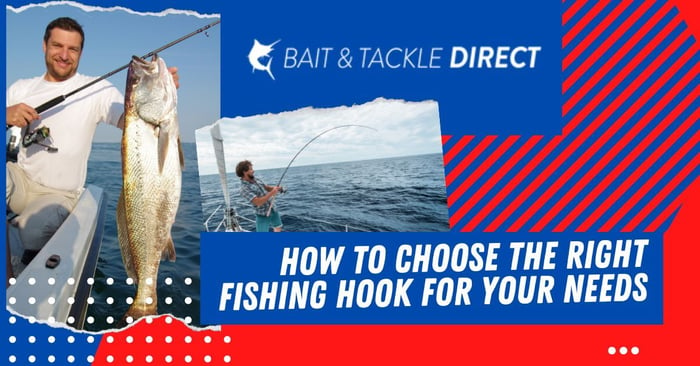Fishing is a wonderful and relaxing pastime that allows you to connect with nature and catch some delicious fish for dinner. But when it comes to choosing the right fishing hook, it can be overwhelming with all the different sizes, shapes, and styles out there. Fear not, my fellow fisherman! I've got you covered with this step-by-step guide on how to choose the right fishing hook for your needs.
Step 1: Determine the type of fish you want to catch
The first step in choosing the right fishing hook is to determine the type of fish you want to catch. Different types of fish require different types of hooks, so it's important to know what you're after before making a decision. If you're fishing for small fish like trout, panfish, or bluegill, you'll need a smaller hook. If you're after larger fish like bass, catfish, or pike, you'll need a larger hook.
Step 2: Consider the hook size
Once you know the type of fish you're after, you'll need to consider the size of the hook. Hook size is measured by a number system, with larger numbers indicating smaller hooks. For example, a size 10 hook is smaller than a size 2 hook. The size of the hook you choose will depend on the size of the fish you're after and the type of bait you're using. If you're using smaller bait, you'll need a smaller hook. If you're using larger bait, you'll need a larger hook.
Step 3: Choose the hook type
Now that you know the size of the hook you need, it's time to consider the type of hook. There are many different types of hooks out there, each designed for a specific purpose. Here are some of the most common types of hooks:
- J-Hooks: J-hooks are the most common type of hook and are great for most types of fishing. They have a simple design with a curved shank and a sharp point.
- Circle Hooks: Circle hooks are great for catch-and-release fishing because they're less likely to cause harm to the fish. They have a circular shape and a sharp point that turns inward.
- Treble Hooks: Treble hooks have three points and are great for fishing with lures. They're also good for catching larger fish because they provide more holding power.
- Baitholder Hooks: Baitholder hooks have barbs on the shank that help keep bait in place. They're great for fishing with live bait.
- Octopus Hooks: Octopus hooks have a short shank and a round bend, making them great for fishing with bait.
Step 4: Consider the material
The material of the hook is also important to consider. Hooks can be made from a variety of materials, including stainless steel, high carbon steel, and nickel. Stainless steel hooks are great for saltwater fishing because they're resistant to rust and corrosion. High carbon steel hooks are stronger and more durable than other types of hooks. Nickel hooks are great for freshwater fishing because they're less likely to rust.
Step 5: Check the point
The point of the hook is the part that penetrates the fish's mouth. It's important to choose a hook with a sharp point, as this will increase your chances of catching a fish. Make sure the hook you choose has a sharp point and is free from any nicks or dents.
Step 6: Consider the hook's strength and durability
The strength and durability of the hook are important factors to consider. You don't want to use a hook that will break easily, especially when you're reeling in a big fish. Look for hooks made of high-quality materials such as stainless steel or carbon steel. These hooks are more durable and can withstand the pressure of catching larger fish.
Step 7: Determine the hook size
The size of the hook is also important. The size of the hook you choose will depend on the size of the fish you want to catch. If you're fishing for small fish, choose a smaller hook. If you're fishing for larger fish, choose a larger hook. You don't want to use a hook that is too big or too small for the fish you're targeting.
Step 8: Choose the hook shape
There are different hook shapes to choose from, including J-hooks, circle hooks, treble hooks, and more. Each shape has its own advantages and disadvantages, so you'll need to choose the one that works best for your needs. J-hooks are versatile and can be used for a variety of fishing techniques, while circle hooks are great for catch-and-release fishing.
Step 9: Consider the hook's color
The color of the hook may not seem like an important factor, but it can make a difference. The color of the hook can affect the fish's behavior and determine whether or not they will take the bait. Choose a hook color that matches the color of the bait you're using.
Step 10: Buy your hooks from a reputable seller
Once you've determined the type of hook you need, it's time to buy them. It's important to buy your hooks from a reputable seller to ensure you're getting high-quality products. Bait Tackle Direct offers a wide selection of fishing hooks for all your fishing needs. Visit their website to browse their collection and find the perfect hook for your next fishing trip.
Choosing the right fishing hook is essential for a successful fishing trip. By considering factors such as the type of fish you're targeting, the fishing technique you're using, the hook's strength and durability, the hook size, shape, and color, you can find the perfect hook for your needs. Don't forget to buy your hooks from a reputable seller like Bait & Tackle Direct to ensure you're getting high-quality products. Happy fishing!


